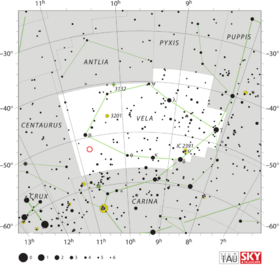Astronomy:V382 Velorum
| Observation data Equinox J2000.0]] (ICRS) | |
|---|---|
| Constellation | Vela |
| Right ascension | 10h 44m 48.3978s[1] |
| Declination | −52° 25′ 31.1686″[1] |
| Apparent magnitude (V) | 2.8 Max. 16.6 Min.[2] |
| Characteristics | |
| Variable type | Nova[2] |
| Astrometry | |
| Proper motion (μ) | RA: −11.885±0.083[1] mas/yr Dec.: 2.690±0.079[1] mas/yr |
| Parallax (π) | 0.5599 ± 0.0547[1] mas |
| Distance | 1800+243 −133[2] pc |
| Other designations | |
| Database references | |
| SIMBAD | data |

V382 Velorum, also known as Nova Velorum 1999, was a bright nova which occurred in 1999 in the southern constellation Vela. V382 Velorum reached a brightness of 2.6 magnitude, making it easily visible to the naked eye. It was discovered by Peter Williams of Heathcote, New South Wales, Australia at 09:30 UT on 22 May 1999. Later that same day it was discovered independently at 10:49 UT by Alan C. Gilmore at Mount John University Observatory in New Zealand.[4][5]
In its quiescent state, V382 Velorum has a mean visual magnitude of 16.56.[6] It is classified as a fast nova with a smooth light curve.[7][8]
Like all novae, V382 Velorum is a binary system with two stars orbiting so close to each other that one star, the "donor" star, transfers matter to its companion star which is a white dwarf. The orbital period is 3.5 hours.[9] The white dwarf in this system has a mass of 1.23M⊙.[10] V382 Velorum is a neon nova, a relatively rare type of nova with a O-Ne-Mg white dwarf, rather than the more common C-O white dwarf.[11]
The stars forming V382 Velorum are surrounded by a small emission nebula about 10 arc seconds in diameter.[12]
References
- ↑ 1.0 1.1 1.2 1.3 1.4 Brown, A. G. A. (August 2018). "Gaia Data Release 2: Summary of the contents and survey properties". Astronomy & Astrophysics 616: A1. doi:10.1051/0004-6361/201833051. Bibcode: 2018A&A...616A...1G. Gaia DR2 record for this source at VizieR.
- ↑ 2.0 2.1 2.2 2.3 Schaefer, Bradley E. (2018). "The distances to Novae as seen by Gaia". Monthly Notices of the Royal Astronomical Society 481 (3): 3033–3051. doi:10.1093/mnras/sty2388. Bibcode: 2018MNRAS.481.3033S.
- ↑ "V382 Velorum". SIMBAD. Centre de données astronomiques de Strasbourg. http://simbad.u-strasbg.fr/simbad/sim-basic?Ident=V382+Velorum.
- ↑ Shore, SN, et al., in The Astronomical Journal, vol. 125, pp. 1507-1518, March 2003
- ↑ Williams, P.; Lee, S.; Pearce, A.; Gilmore, A.C.; Pollard, K.R.; McSaveney, J.A.; Kilmartin, P.M.; Caldwell, P. (May 1999). "Nova Velorum 1999". IAU Circular 7176: 1. Bibcode: 1999IAUC.7176....1L. https://ui.adsabs.harvard.edu/abs/1999IAUC.7176....1L. Retrieved 7 December 2020.
- ↑ Platais, Imants; Girard, Terrence M.; Kozhurina-Platais, Vera; Vanaltena, William F.; Jain, Raj K.; Lopez, Carlos E. (February 2000). "Nova Velorum 1999=V382 Vel: Astrometry and Photometry". Publications of the Astronomical Society of the Pacific 112 (768): 224–227. doi:10.1086/316505. Bibcode: 2000PASP..112..224P.
- ↑ Dellavalle, M.; Pasquini, L.; Daou, D.; Williams, R.E. (July 2002). "The evolution of Nova V382 Velorum 1999". Astronomy & Astrophysics 390: 155–166. doi:10.1051/0004-6361:20020611. Bibcode: 2002A&A...390..155D. https://www.aanda.org/articles/aa/pdf/2002/28/aa2397.pdf. Retrieved 7 December 2020.
- ↑ Strope, Richard J.; Schaefer, Bradley E.; Henden, Arne A. (July 2010). "Catalog of 93 Nova Light Curves: Classification and Properties". The Astronomical Journal 140 (1): 34–62. doi:10.1088/0004-6256/140/1/34. Bibcode: 2010AJ....140...34S.
- ↑ Balman, Solen; Retter, Alon; Bos, Marc (May 2006). "The Detection of a 3.5 hr Period in the Classical Nova Velorum 1999 (V382 Vel) and the Long-Term Behavior of the Nova Light Curve". The Astronomical Journal 131 (5): 2628–2633. doi:10.1086/503161. Bibcode: 2006AJ....131.2628B. https://iopscience.iop.org/article/10.1086/503161/pdf. Retrieved 7 December 2020.
- ↑ Hachisu, Izumi; Kato, Mariko (June 2019). "A Light-curve Analysis of 32 Recent Galactic Novae: Distances and White Dwarf Masses". The Astrophysical Journal Supplement Series 242 (2): 18. doi:10.3847/1538-4365/ab1b43. Bibcode: 2019ApJS..242...18H.
- ↑ Hachisu, Izumi; Kato, Mariko (1 January 2016). "Light-curve Analysis of Neon Novae". The Astrophysical Journal 816 (1): 26. doi:10.3847/0004-637X/816/1/26. Bibcode: 2016ApJ...816...26H.
- ↑ Takeda, Larissa; Marcos, Diaz (May 2019). "Imaging and Analysis of Neon Nova V382 Vel Shell". Publications of the Astronomical Society of the Pacific 131 (999): 054205. doi:10.1088/1538-3873/ab0a47. Bibcode: 2019PASP..131e4205T.
External links
- https://web.archive.org/web/20060517025834/http://institutocopernico.org/cartas/v382velb.gif
- https://web.archive.org/web/20050915104557/http://www.tsm.toyama.toyama.jp/curators/aroom/var/nova/1990.htm
 |


